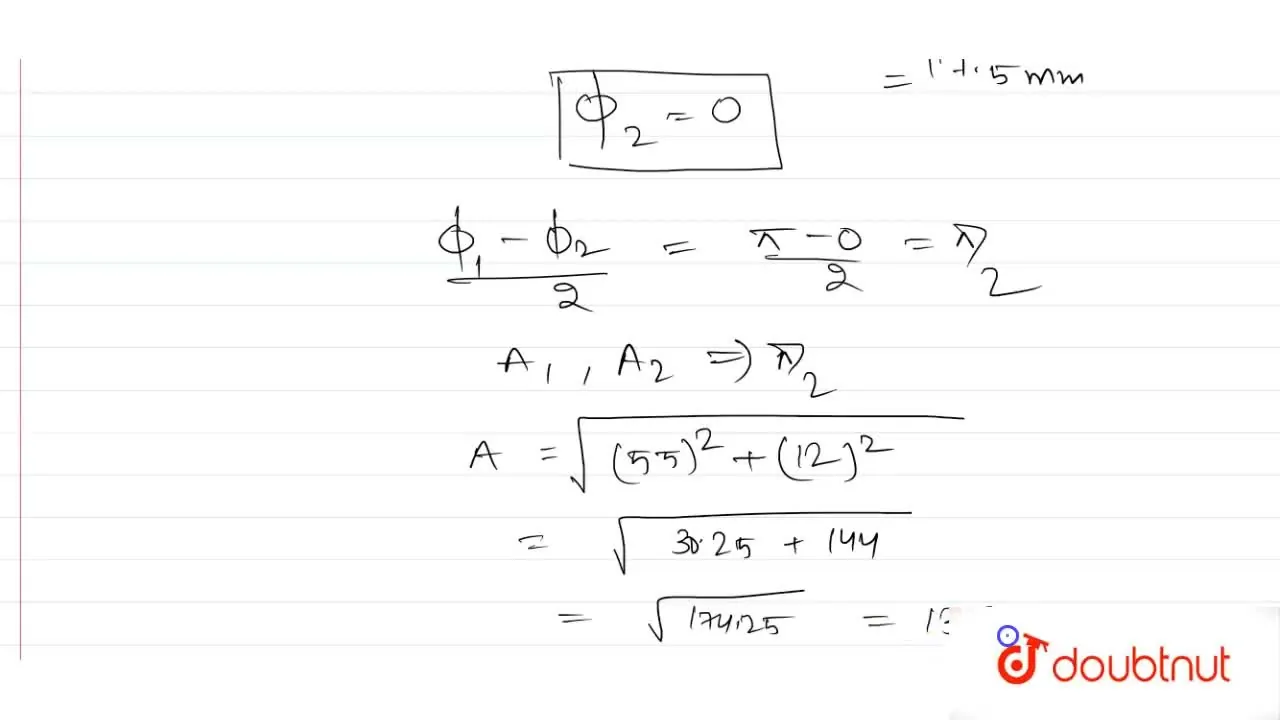Two sinusoidal waves of the same frequency are to be sent in the same direction along a taut string. One wave has an amplitude of 5.50 mm, the other 12.0 mm. (a) What phase difference between the two waves results in the smallest amplitude of the resultant wave? (b) What is that smallest ! amplitude? (c) What phase difference results in the largest amplitude of the resultant wave? (d) What is that largest amplitude? (e) What is the resultant amplitude if the phase angle is
The correct Answer is:(a) pi rad; (b) 6.50 mm; (c) 0 rad; (d) 17.5 mm (e) 13.2 mm
Step by step video, text & image solution for Two sinusoidal waves of the same frequency are to be sent in the same direction along a taut string. One wave has an amplitude of 5.50 mm, the other 12.0 mm. (a) What phase difference phi_(1) between the two waves results in the smallest amplitude of the resultant wave? (b) What is that smallest ! amplitude? (c) What phase difference phi_(2) results in the largest amplitude of the resultant wave? (d) What is that largest amplitude? (e) What is the resultant amplitude if the phase angle is (phi_(1)-phi_(2))//2? by Physics experts to help you in doubts & scoring excellent marks in Class 12 exams.
Related Playlists
- BOOK - RESNICK AND HALLIDAYCHAPTER - WAVES-IEXERCISE - Practice Questions (Single Correct Choice Type)33videos
WAVES-I
- BOOK - RESNICK AND HALLIDAYCHAPTER - WAVES-IEXERCISE - Practice Questions (More than One Coorect Choice Type)10videos
WAVES-I
- BOOK - RESNICK AND HALLIDAYCHAPTER - WAVES-IEXERCISE - Checkpoint8videos
WAVES-I
- BOOK - RESNICK AND HALLIDAYCHAPTER - WAVE - IIEXERCISE - PRACTICE QUESTIONS (INTEGER TYPE)5videos
WAVE - II
- BOOK - RESNICK AND HALLIDAYCHAPTER - WORK, POWER, AND ENERGYEXERCISE - PRACTICE QUESTIONS (Integer Type)5videos
WORK, POWER, AND ENERGY
Similar Questions
Two sinusoidal wave of the same frequency are to be sent in the same direction along a taut string. One wave has an amplitude of 5.0mm, the other 8.0mm. (a) What phase difference ϕ1 between the two waves results in the smallest amplitude of the resultant wave? (b) What is that smallest amplitude? (c) What phase difference ϕ2 results in the largest amplitude of the resultant wave ? (d) What is that largest amplitude? (e) What is resultant amplitude if the phase angle is (ϕ1−ϕ2)/2?
View SolutionWhat is phase difference between two waves, if the resultant amplitude due to their superposition is same as that of the waves?
View SolutionIf the phase difference between the two wave is 2π during superposition, then the resultant amplitude is
View SolutionTwo sine waves travel in the same direction in a medium. The amplitude of each wave is A and the phase difference between the two waves is 120^@. The resultant amplitude will be
View SolutionTwo identical sinusoidal waves, moving in same direction along a stretched string, interfere, with each other. The amplitude of each wave is 10.0mm, and the phase difference between them is 80∘. What is the amplitude of the resultant wave and the nature of interference ?
View SolutionTwo identical sinusoidal waves each of amplitude 5 mm with a phase difference of π/2 are traveling in the same direction in a string. The amplitude of the resultant wave (in mm) is
View SolutionTwo identical sinusoidal waves each of amplitude 10 mm with a phase difference of 90∘ are travelling in the same direction in a string. The amplitude of the resultant wave is
View SolutionTwo sinusoidal waves of the same period, with amplitudes of 5.0 and 7.0 mm, travel in the same direction along a stretched string, they produce a resultant wave with an amplitude of 10.0 mm. The phase constant of the 5.0mm wave is 0. What is the phase constant of the 7.0mm wave?
View SolutionTwo sound waves travel in the same direction in a medium. The amplitude of each wave is A and the phase difference between the two waves is 120∘. The resultant amplitude will be
View SolutionTwo identical sinusoidal waves, moving in the same direction along a stretched string, interfere with each other. The amplitude y of each wave is 9.8 mm, and the phase difference p between them is 100∘.
(a) What is the amplitude y. of the resultant wave due to the interference, and what is the type of this interference?
(b) What phase difference, in radians and wavelengths, will give the resultant wave an amplitude of 4.9 mm?View Solution


